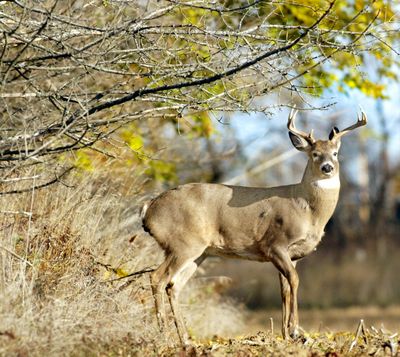The rut leads whitetails to abandon wary ways

A whitetail hunter is always up for the mating season.
The rut, as it’s called, is a short window of opportunity exercised by the deer and the sportsmen alike.
For the buck, a few weeks of November are his best chance to find receptive does ripe to breed.
For the buck hunter, the rut is the rare break to find the largest, wiliest bucks letting down their guard.
As deer hormones surge with the season to swell their necks and genitals, big bucks that haven’t stepped into the open in the light of day since September will seemingly lose peripheral vision and common sense in pursuit of procreation.
Head held low and nose extended, a buck will follow a doe in estrus virtually anywhere – perhaps into the nearest shopping mall if she chose to go there.
To wildlife biologists, the word “rut” usually means the peak period of big-game coitus and conception.
But it behooves hunters to regard the rut more broadly. Success in bagging a buck can be improved by adjusting hunting strategies as bucks advance through the stages of the rut – rubbing, scraping, fighting and chasing – and into the peak breeding period.
Concentrated breeding activity is nature’s way of boosting the species’ survival.
“Some of the deer are bred early and they have their fawns early,” said Hal Meenach, a Spokane County landowner and wildlife habitat consultant. “But those early fawns are more susceptible to predation because there are so few of them.
“When lots of does are giving birth all at once, the predators can’t keep up, and fawn survival rates increase.”
Researchers have pegged the statistical peak of the rut – that is, the crest on the graph of whitetail conceptions – as Nov. 21 in northwestern Montana and Nov. 23 in northeastern Washington.
In turn, the peak of whitetail fawn births is around June 8-10 based on a mean gestation period of 201 days.
These findings led the Washington Fish and Wildlife Department 10 years ago to set an annual Nov. 19 end to the late modern firearms whitetail season to prevent overhunting the largest bucks at their peak of vulnerability.
However, in Montana, where whitetail numbers are strong and hunting pressure generally is lighter, hunting seasons run through the rut, ending Nov. 28.
“Our whitetails are very productive, and the buck-to-doe ratios are real high,” said Mark Sullivan, Montana wildlife biologist in Glasgow. “Most of the whitetails occur on private land, where there’s plenty of security for bucks to grow to older age classes.”
Declines in northwestern Montana deer herds are more likely associated with high numbers of cougars rather than hunting, said Alan Wood, Fish, Wildlife and Parks biologist in Kalispell.
The bucks have less security in Washington, where Colville-area hunting groups have asked for even more restrictions in some areas to help bucks survive to older ages.
“Yearling bucks make up the bulk of the bucks taken in the early season, while we see an increase in the percentage of bigger bucks later in the season during the rut,” said Dana Base, Washington Department of Fish and Wildlife biologist in Colville.
“Part of that is because the bucks become more vulnerable and part of it is selectivity: The people who go out in the cold, wet weather of the late season are the serious hunters who aren’t willing to settle for a spike or two-point.”
Meantime, many hunters say the best buck hunting occurs in the week or two leading to the peak of the rut, especially if the weather cooperates with colder temperatures and winds don’t howl. Snow is always a plus.
Gary Dusek, co-author of Montana’s most thorough study on white-tailed deer, is a devotee of hunting the pre-rut period. Dusek is a recently retired Montana FWP biologist who’s living in Liberty Lake.
“Rattling is quite effective in the two or three weeks prior to the peak of the rut,” he said, referring to the technique of clapping and raking two shed antlers together or against a tree to simulate the sound of sparring or rubbing bucks.
“They respond to rattling and grunting best during that period. Later, you’re a lot less likely to pull away a buck that’s tending a doe.”
Dusek, as a hunter and researcher, has devoted many hours to watching whitetails from long distances to observe their behavior and how they respond.
“The older bucks that have survived a couple of seasons probably are more cautious to pre-rut rattling, but the 2- and 3-year olds will charge right in for a 45-yard shot in the timber.”
“Things come to a head about the 17th of November,” he said. “I’d be willing to say I’ve shot more bucks on that date, plus or minus a day.”
“The more they visit scrapes, the closer they are to the rut,” he said.
“Scrapes enable the hunter to clearly see where the bucks are,” said Wood, who worked with Dusek on the Montana whitetail study. “They do work a circuit. They mark their territory and share information with other deer. Hunters who find active scrapes know they’re in a good area to get a buck.”
“But you still have to use stealth,” Dusek said. “They’re whitetail bucks. They’re not that dumb, even in the rut.”